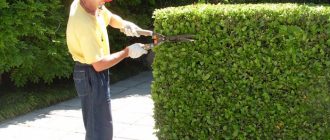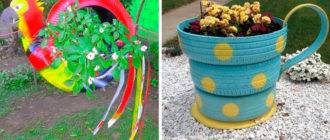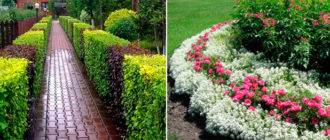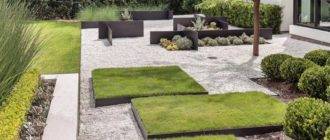The thorny hedge is a unique fence that provides shade and protects from prying eyes. Animals and uninvited guests cannot get through the dense thickets with thorns. It is important to choose the right shrubs for the type of soil, lighting. Fences are created along territorial boundaries or when zoning huge areas.

Varieties of thorn hedge
Conventionally, all thorny shrubs can be divided into three large groups:
- decorative, they are planted only to create a green fence;
- blooming, they are usually undersized, they can be used independently or when decorating tiered hedges;
- berry, they will delight you with healing fruits, a good harvest.
Tight plantings are difficult to handle and look untidy.

In small areas, it is more appropriate to use berry fields as a hedge. They will protect you from prying eyes, will delight you with the harvest.
Read about how to choose berries to create a beautiful hedge in your garden.
Types and varieties of thorny shrubs for hedges
All plants listed in the table form a dense crown, are well formed. Propagated by cuttings or layering.

3–6-year-old seedlings are transferred to a permanent place in early spring or late autumn.
I recommend looking at several crops and varieties that create thorn hedges. You can pick up plants of any height, color.

| Shrub and variety name | Description | Planting and leaving |
| Hawthorn | ||
| Barbed | Up to 5 m. The crown is pyramidal. Thorns up to 3 cm. Leaves are oval, divided into 3-5 lobes. Pink buds, collected in dense inflorescences. Edible berries, purple, yellow at the break, high in sugars. | The culture is winter-hardy, drought-resistant, unpretentious to the soil, responds well to feeding. At high humidity, fungal infections are possible. |
| Blood red | Up to 4 m. The crown is spherical. Thorns up to 5 cm. Flowers are white or pinkish. The berries are mealy, edible, ripen in late autumn. | Winters well, likes moderate watering, is resistant to partial shade. Susceptible to powdery mildew. |
| Altaic | Up to 8 m. The crown is pyramidal. Thorns up to 2 cm. Inflorescences are dense, white. The berries are amber or orange. Astringent, edible. | Unpretentious to soil, moisture. Loves good lighting. Resistant to fungal infections. When feeding, the sugar content of the fruit increases. |
| Meat green (green pulp) | Up to 6 m. The crown is pyramidal. Spines are rare, up to 1.5 cm long. Leaves are oval, serrated. Berries with black skin, green inside, pleasant to the taste. | The variety adapts well to any conditions. Bears abundantly every year. It responds well to formative autumn pruning. |
| Thorn | ||
| Purple | 2.5 m.The crown is knotty, dense. The dark purple oval leaves turn green towards fall. The flowers are pale pink. Fruits are oval, dark-gray, tart, edible. | The shrub loves well-lit places. Ripens faster in fertile soil. Sanitary pruning is recommended in spring, shaping in autumn. Complex feeding is applied in the flowering phase. Watering is carried out only during dry periods when the foliage withers. |
| Terry | Up to 2 m. Differs in lush flowering, straight, even shoots. The leaves are obovate. The fruits are round, small. | |
| Red-leaved | Up to 3 m, the crown is dense. Leaves are medium in size, burgundy in color. The fruits are large, red, sweetish. | |
| Rose hip | ||
| Barbed | Up to 2 m. Flowers are white or yellow, large, multi-row. Fruits are flattened, yellow-orange. | Unpretentious, grows quickly without pruning. Top dressing is applied no more than once every three years. |
| Canine | Up to 3 m. Leaves are bright green. The flowers are pink, three-layered. The fruits are large, orange. | It takes root well in any conditions.On poor soil, the flowers become smaller, the bush runs wild. |
| Wrinkly | Up to 1.5 m. Leaves with fine wrinkles. Forms a compact bush. | Resistant to frost, photophilous. Sanitary pruning in early spring is sufficient. |
| Roses | ||
| Rambler
Climbing. |
They grow up to 2 m. Small buds appear on 2-year-old branches. Abundant flowering, long lasting. | Bushes require supports, strapping. For the winter, the soil is mulched for frost resistance. They love good lighting, well-drained soil. |
| Barberry | ||
| The varieties are especially decorative:
Thunberg red, inedible fruit; Ottawa with a maroon crown, turning yellow by autumn; Albo variegata with variegated whitish foliage |
The height of the bush is from 1.5 to 3 m. It spreads by self-seeding, thickens itself. The leaves are small, oval. Abundant flowering, white, pink or yellow buds. The berries are elongated, red, edible in most varieties. | The bush is easily affected by powdery mildew, brown rust. Requires constant thinning. Crown pruning is carried out in the spring. Top dressing with calcium, phosphorus, potassium during the budding period. |
| Blackberry | Small, dense spines up to 3 m. The foliage is carved. The berries are granular, elongated up to 3 cm long, sweet and sour. | The bush grows in neutral or alkaline soil, demanding lighting. Drought-resistant. The hedge is formed on trellises. |
| Sea buckthorn | Shrubs or trees from 2 to 6 m. Leaves are narrow, pinnate. The berries stick to the trunk tightly, in the ripeness phase they are orange or bright yellow. | The plant is unpretentious. Planting must be thinned out, cut off the root shoots. Top dressing is applied once a year. |
| Gooseberry | Bushes up to 1.2 m, straight branches. Even thornless varieties become thorny over time. | Loves humus-rich soil. For full fruiting, the bush in the spring requires organic matter, in the summer, phosphorus, potassium, calcium. The bushes are often affected by powdery mildew. |
| Raspberries | Up to 2.5 m. Fruits in the second year. Forms dense thickets. | Thickets must be cut out annually, dried shoots are removed under a stump. Loves feeding, good lighting. It is advisable to tie the shoots to the trellises. |
| Chinese prinsepia | Up to 2 m. The crown is spreading, loose. Spines up to 2 cm, rare. Leaves are narrow, elongated, turn yellow in autumn. The flowers are yellow or white, small, collected in clusters. | Resistant to freezing, soaking. Top dressing is applied annually in early spring, after which loosening is carried out. |
| Tree caragana (yellow acacia, pea) | Up to 4-6 m. The crown is dense. The leaf arrangement is paired with a central top leaf. Yellow buds are collected in a brush. Small pods are formed at the end of July. | The culture is unpretentious to soil, lighting. Prone to damage by powdery mildew. Loves potassium dressing. Well formed. |





